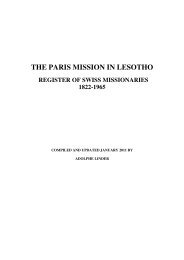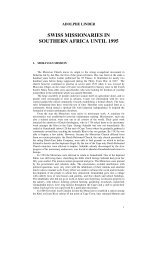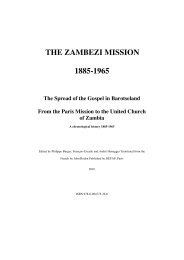THE SWISS IN SOUTHERN AFRICA 1652-1970 - swissroots-za.ch
THE SWISS IN SOUTHERN AFRICA 1652-1970 - swissroots-za.ch
THE SWISS IN SOUTHERN AFRICA 1652-1970 - swissroots-za.ch
You also want an ePaper? Increase the reach of your titles
YUMPU automatically turns print PDFs into web optimized ePapers that Google loves.
learned to love. Only ten are known to have done so: Jakob Marik of Präz GR in 1710,<br />
Joseph Coen of Berne in 1746, Gabriel Jenny of Ennenda GL and Anthony Castelyn in<br />
1757, Heinri<strong>ch</strong> S<strong>ch</strong>warz of Wülflingen ZH in 1758, Coenraad Roets of Appenzell 1763,<br />
Hans Soeblee of Bougy-Villars VD in 1764, Johan Coenraad Wegelien of Diessenhofen<br />
TG in 1775, Nicolaas S<strong>ch</strong>laub of Basel in 1785 and Thomas S<strong>ch</strong>oenmaker in 1790.<br />
/ 1 Bruijn: Dut<strong>ch</strong> Asiatic Shipping in the 17 th and 18 th Centuries, gives a detailed<br />
report on every sea voyage undertaken; 2 Thunberg: Travels in Europe, frica & Asia; 3<br />
Boxer: The Dut<strong>ch</strong> East-Indiamen; 4 Herport, Albre<strong>ch</strong>t: Reise na<strong>ch</strong> Java, Vorderindien &<br />
Ceylon 1659-1668.<br />
4.3 Company Servants<br />
The number of Dut<strong>ch</strong> ships sailing around the Cape increased continuously,<br />
transporting increasing numbers of men. During the ninety years from 1610 to 1799 a<br />
total of 1 074 ships called at the Cape, whereas for the next ninety-five years from 1700<br />
to 1794, this number nearly trebled to 2 851. It is estimated that the ships carried one<br />
million men to the Cape mainly en route to the East, but only brought back about three<br />
hundred thousand (30%). This caused an unsustainable drain on Dut<strong>ch</strong> manpower, but<br />
fortunately the Netherlands had a large hinterland extending southward to the Alps and<br />
northward to Scandinavia, from whi<strong>ch</strong> it could attract men. Mostly these came from<br />
adjoining German states – indeed, there were years when the entire garrison at the Cape<br />
consisted of Germans with a sprinkling of Swiss.<br />
The Directors of the VOC in the Netherlands wished to be fully informed of<br />
everything that happened at their overseas trading stations. The scribes at the Cape were<br />
kept busy writing detailed records. One of the most important was the annual Muster<br />
Roll listing all the Company’s employees and their pay, the Company’s major expense<br />
item. Besides name and salary, these rolls also recorded birthplace, position in whi<strong>ch</strong><br />
employed and generally also the name of the ship and the date on whi<strong>ch</strong> they arrived..<br />
Copies of these rolls had to be sent to the Netherlands. Other records were retained,<br />
ready to be inspected by visiting commissioners. Nearly all this documentation has been<br />
preserved at the Algemeen Rijksar<strong>ch</strong>ief, The Hague (ARA) and the Cape Ar<strong>ch</strong>ives, Cape<br />
Town (CA). In addition the CA has Verbatim Copies (VC) and / or microfilm of the<br />
documents kept at the ARA but whi<strong>ch</strong> are not extant at the Cape.<br />
The annual Muster Rolls (MR) were the main source of information for drawing up<br />
the register of Swiss who came to the Cape as Company servants. Several copies of<br />
these rolls exist but names were sometimes left out or spelt differently. For some<br />
unknown reason many Rolls are missing at the Cape Ar<strong>ch</strong>ives. For instance for the<br />
twenty-three years from 1673 to 1695 only two rolls could be found. (See Table 3, p.<br />
13)<br />
4.4 Swiss Labour Migration to the Netherlands<br />
The Alps were unable to accommodate the growing population and since early times<br />
many young Swiss had to find their living abroad. Mostly the men served as mercenary<br />
soldiers in foreign armies; they were renowned for their military prowess and mu<strong>ch</strong><br />
sought after. Those not martially inclined sought work on farms, in households and in<br />
industry. After the Thirty Years War (1618-1648) Germany, with its population<br />
drastically reduced and vast areas ravaged, offered work and <strong>ch</strong>eap land. Large numbers<br />
of Swiss took advantage of the opportunities available there. By the time this vacuum<br />
had been filled, the Netherlands had grown prosperous from the spice trade, and good<br />
work opportunities could be found there. Later America became the promised land. The<br />
first emigrants from Switzerland went there in about 1730 and soon glowing reports<br />
filtered back attracting many more. Emigration across the Atlantic Ocean increased<br />
steadily and peaked in the 1880’s at nearly 1% per annum of the total Swiss population.<br />
12







